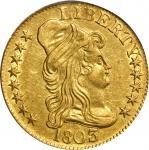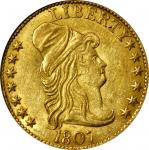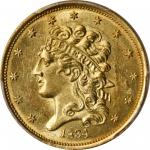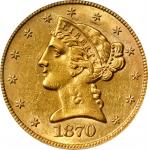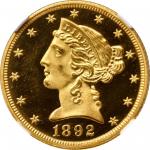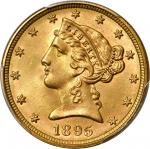1795 Capped Bust Right Half Eagle. Small Eagle. BD-10. Rarity-5. MS-62 (PCGS). Thoroughly appealing in all regards, this premium BU 1795 Small Eagle $5 is sure to sell for a strong bid to an advanced numismatist. Warm honey-apricot color both sides, the surfaces reveal lighter golden-apricot patina when viewed with the aid of direct lighting. Both sides are modestly prooflike in finish. Yet whereas the fields are semi-reflective, the design elements are set apart with a soft satin texture. Overall sharply defined from a nicely centered and well executed strike, we note just a touch of softness to the high points that is extremely minor in an example of this challenging early U.S. Mint gold design type. An attractive and highly desirable coin that has tremendous historical significance. BD Die State c/a.<p>As with the larger $10 eagle, the $5 half eagle was authorized by the Act of April 2, 1792, that established the United States Mint and defined the nations monetary system. These earliest gold coins do not include an expression of the denomination as part of the design, a curious feature for someone familiar only with modern U.S. coinage. This was no oversight, however, as these denominations were stated by law in the aforementioned 1792 Act. Section 20 states "That the money of account of the United States shall be expressed in dollars or units, dismes or tenths...." Naturally, the value of gold to silver was also set forth in this Act. The Act defined the ratio of pure silver to gold as 15 parts to one being of equal value. Therefore, the relative denominations were consistent fractions, tenths or related logical fractions of the "unit" or dollar measure of silver or gold. Merchants always weighed coins in transactions, and their values were determined by experience and the trustworthiness of the money issuer. A gold half eagle would be understood to contain the proper ratio of gold to silver, being worth five silver dollars or units. Clearly the young United States of America had to prove sound coinage on an international, as well as local front.<p>The Act of 1792 also stated "That the said assayer, chief coiner and treasurer" of the Mint each had to be bonded to the United States of America for $10,000 with the condition for the faithful and diligent performance of the duties of their respective office. A $10,000 bond was a staggering amount of money at the time. It was only after a reduction in the bond requirement and the help of sureties, that the beginning of gold coinage was achieved in July 1795 with the delivery of the first half eagles. Ten-dollar eagle coinage began in September of that year.<p>The Capped Bust Right half eagle and eagle are both the work of Robert Scot, who became engraver at the Philadelphia Mint after Joseph Wright died in one of the annual yellow fever epidemics. Scots device punch for Libertys portrait was used to create new dies as they were needed. He is also believed to have created the delicate "small eagle" hub punch for the reverse.<p>Mint records state that 8,707 half eagles were struck in 1795, although based on the number of coins extant John W. Dannreuther (<em>Early U.S. Gold Coin Varieties: A Study of Die States, 1795-1834</em>, 2006) estimates that the mintage could have been upward of 12,106 pieces. The Mint prepared eight obverse dies for 1795-dated half eagle production, and with high quality steel in short supply, the coiners almost certainly continued to use these dies in later years. This was common practice in the early United States Mint, making yearly mintage figures a poor indicator of the actual number of coins struck for many issues.<p>The BD-10 variety offered here is among the scarcer of the 12 known die marriages of the 1795 Small Eagle $5. Only about 750 to 1,250 coins are believed to have been struck using this die pair, and the mass meltings of gold coins that occurred in the 1820s and 1830s certainly took their toll. John W. Dannreuther (2006) accounts for just 40 to 50 survivors in all grades. This is only our second offering for the variety since 2013, and it is for a well produced, carefully preserved and aesthetically pleasing Mint State coin that is decidedly rare in this grade. With strong demand from early gold enthusiasts and high grade type collectors, this coin is sure to see spirited bidding at auction.<p>This variety represents the only use of this reverse die, which is readily identifiable by repunching to the base of the second letter T in STATES. Harry W. Bass, Jr. owned two examples of this variety, both in BD Die State c/b with a crack through the final letter A in AMERICA and a break in the denticles outside the letter I in UNITED. Whether these breaks were sufficient to force Mint personnel to retire this die is unknown, although to date no coins in a later reverse die state have been confirmed. The present example was struck from the early state of the reverse with no cracks evident on that side of the coin. From the Castle Pines Collection.



